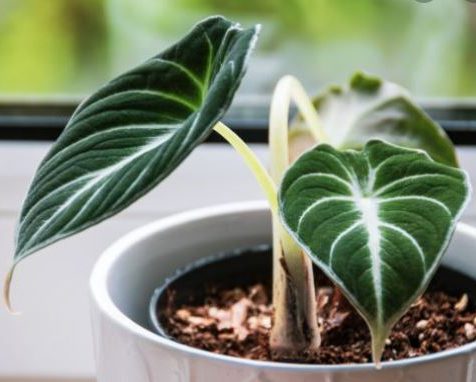Ficus Tineke is a low to bright light houseplant that likes to dry out in between watering. The darkly colored foliage highlighted with borders of white fit well with many kinds of decor. It belongs to the Moraceae family and the plant’s genus name means “edible fig.”
Ficus Tineke Care

Dimensions and Growth
The dimensions of these leaves can reach around 12″ inches and 5 inches ″ inches broad.
Ficus Tineke produces glistening variegated leaves reaching around 12″ inches and 5 inches ″ inches broad. Tineke displays impressive variegated lotion to nearly green and white leaves. Some indicate the leaf color appears like watercolor.
The burgundy rubber tree is really actually just a fast-growing ficus elastica tineke.
Flowering and Fragrance
Flowering indoors is just really a rare phenomenon. If Ficus does blossom they’re simple white blossoms.
Its minimal odor only brings fig wasps no other sort of pollinators.
Light and Temperature
It’ll tolerate lower lighting requirements but using less creamy variegation to the leaves that are new.
Indoors maintain ordinary room temperatures above 55° degrees Fahrenheit using moderate humidity degrees. Look at including a humidifier to boost humidity.
Inconsistent temperature, abrupt temperature drops or cold weather, and arid states could impact this ficus elastica tineke.
Watering and Feeding Ficus Plants
The Ficus Tineke is actually a rather low-maintenance plant. Be careful to not overwater plants. In the event the origins sit in water, then they are able to suffer from root rot and fungus gnats could eventually become a concern.
The indoor ficus will still hunt watering depending on this natural growing up. Water your plant longer through the summertime and cut during the wintertime.
During warmer weeks nourish your plant per month by having a half-strength balanced liquid fertilizer.
Soil and Transplanting
It works nicely in acidic or alkaline soil. Don’t water until the upper inch of the ground remains still dry.
Don’t overpot. Your plant ought to be OK from the bud it was bought to get annually. In case it becomes top-heavy make work with of a cachepot to continue to keep it from falling.
When repotting, re-pot during early spring to never jolt your plant life. Ficus elastica tineke shows shock by falling leaves.
Ficus Tineke grooming and care

As a house ficus elastica tineke plant, the rubber plant won’t require much pruning. Mature ficus elastica tineke plants might involve pruning to preserve their contour or remove branches that are unwanted.
To reach a bushier, more slender silhouette, prune the key branches.
For a slimmer treelike look, don’t snore.
Every once in a while, wash the thick, thick waxy leaves using a damp cloth.
Your Ficus tree can grow airborne roots — roots that grow above the earth – if it becomes larger.
These origins help stabilize the shrub but are not vital. Eliminating these airborne roots won’t damage your ficus elastica tineke life.
The Way You Can Propagate Ficus Rubber-tree Plants
Ficus elastica Tineke is simple to disperse.
This practice is straightforward but will get cluttered as a result of milky sap that it stinks when trimming.
- Pick a branch to spread and require a cutting around 12″ inches
- Eliminate the leaves
- Employ a rooting hormone into the bottom of this trick cutting
- Put to a fresh kettle full of well-draining dirt
- Water and then put a plastic bag on the kettle to make a synthetic greenhouse. A soft drink bottle is effective too
- Set your fresh cutting in a hot, sunny site. No sunlight
- New origins should shape in 30-60 days
- After your brand fresh Ficus Tineke is nicely set, repot into a bigger 6″ bud.
Ficus Tineke Pests or Diseases
Variegated plants such as Tineke tend to be fleas such as foliage and origin mealybugs, aphids, plant growth, and spider mites.
As with other rubber plants, ficus elastica tineke can at times be more prone to fungal infections like Anthracnose.
All variegated ficus elastica tineke varieties appear to have problems with some type of brownish spots on the leaves. The causes of brown stains?
Too much immediate light may burn.
Low humidity can dry up the leaves.
Over-fertilizing can Lead to burns off from salt accumulation
Ficus Rubber Trees usually do not like fluctuations. They enjoy:
Constant Temperatures — Once subjected to drops in temperatures they react with falling leaves.
Moist maybe not Wet Soil — When the soil remains too dry after which remains wet. Roots grow to be mushy and begin to perish.
Intelligent indirect lighting — ficus elastica tineke produces leaves dependent on the light that they receive. Once the leaves usually do not”fit” the light requirements. They shed leaves.
Briefly about ficus elastica tineke
- Position: bright but indirect light
- Soil: good potting compost
- Rate of growth: average to fast
- Hardiness: tender (indoors only)
- Current height: approximately 14 inches (+ or – 10% including the pot)
- Pot cover: choose a 5 inches pot cover to give a good fit over the pot
These are easy plants to care for as long as you are careful with the watering. Only water once the compost is dry to the touch, and make sure that the plant isn’t left standing in water. You can mist the leaves during the summer to increase the humidity. Occasionally wash the leaves with a damp sponge or cloth to keep the foliage glossy. Try to maintain an average temperature no lower than 12°C in the winter, and avoid any sudden drops in the temperature and cold draughts.

